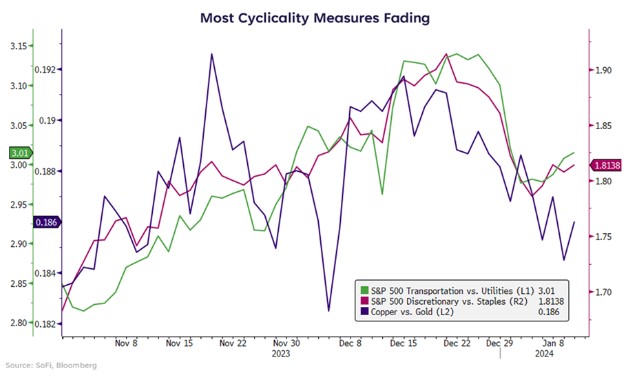Market Signals So Far

Estimated reading time: 0 minutes
Prevail or Fail?
It’s been a bumpy start to the year after the stock market rally stalled in late December. Although a new high wasn’t made in the S&P 500, the index has been hovering near the all-time closing high of 4,796 from January 2022.
The question investors are asking now is: will the rally prevail and break through with further upside, or will it fail to get above this sticky spot?
Starting at the end of October, markets displayed what most called a broadening out. More specifically, some of the cyclical comparisons we like to see in a healthy and durable rally started to light up positively. A few of those comparisons are shown in the chart below, and it’s evident that all three examples trended upward for most of November and December.
But since late December, many of these indicators reversed course and now have people wondering if the rally was as promising as it seemed.
Breaking Records is Hard
And it should be… that’s what makes record-breaking such worthy headline material. It’s especially hard when the economy is headed back to “normal” at best, and contraction at worst. Regardless of whether you’re bullish or bearish, it’s no wonder the market gets a little wobbly right around record highs. This is the point where investors ask themselves whether the companies that make up the index deserve higher prices than they did the last time we were at this level.
One of the trickiest aspects of investing is the fact that markets move at different times than economic data, and it’s impossible to know for sure whether the market is correctly signaling an upcoming shift in the economy. Not to mention, markets move rapidly and change directions frequently, which can make these signals difficult to rely on for long periods of time.
Case in point, one of the more frequent economic data points we watch is continuing jobless claims. In our 2024 outlook we wrote that a bet on a soft landing is a bet on the consumer. And a bet on the consumer is a bet on the labor market. Continuing jobless claims give us a weekly read on the trend in applications for unemployment benefits, and can serve as an early indicator of a cooling economy.
Interestingly, just before the market rallied late in the year, continuing jobless claims were on a steady grind higher. So the market was sending pro-cyclical signals while more people were filing for jobless benefits.
And just when those filings stopped rising, so did the market. This seems counterintuitive: The claims topped out (for the time being) right around the pre-pandemic average, and markets started to fall. But since markets are supposed to move before the data shows a shift, perhaps this makes more sense.
The trouble now is, what are these market signals saying about upcoming economic data? It would appear they’re foreshadowing weakness.
Banking on Banks?
One of the industry groups that isn’t faltering with the other cyclicals is banks. If the rest of the market is right (keep in mind, we’re only talking about a couple weeks of signals here), banks would be expected to be under pressure too, but they’ve held on quite well.
Much of this can likely be explained by the market’s expectation for falling interest rates, particularly on the short end of the curve. The straightforward benefit for banks would be improving net interest margin, and if we couple that with a soft landing, banks look pretty good right now. Key words being “right now”.
The big banks are set to start reporting Q4 earnings at the end of this week. December CPI data will have been released by the time this post is online. Things could change quickly, but for now, banks are sending a positive signal while many other cyclical indicators are feeling unsure. The survey of bulls versus bears still shows a wide spread, with bulls handily on top.
So far, soft landing hopes are still alive, and the turn in some of these cyclical indicators hasn’t convinced many investors otherwise.
Disclaimer
SoFi Securities (Hong Kong) Limited and its affiliates (SoFi HK) may post or share information and materials from time to time. They should not be regarded as an offer, solicitation, invitation, investment advice, recommendation to buy, sell or otherwise deal with any investment instrument or product in any jurisdictions. Keep in mind that investing involves risk, and past performance of an asset never guarantees future results or returns. It’s important for investors to consider their specific financial needs, goals, and risk profile before making an investment decision.
SoFi HK does not make any warranties about the completeness, reliability and accuracy of this information and will not be liable for any losses and/or damages in connection with the use of this information.
The information and materials may contain hyperlinks to other websites, we are not responsible for the content of any linked sites. The information and analysis provided through hyperlinks to third party websites, while believed to be accurate, cannot be guaranteed by SoFi HK. These links are provided for informational purposes and should not be viewed as an endorsement. The risk involved in using such hyperlinks shall be borne by the visitor and subject to any Terms of Use applicable to such access and use.
Any product, logos, brands, and other trademarks or images featured are the property of their respective trademark holders. These trademark holders are not affiliated with SoFi HK or its Affiliates. These trademark holders do not sponsor or endorse SoFi HK or any of its articles.
Without prior written approval of SoFi HK, the information/materials shall not be amended, duplicated, photocopied, transmitted, circulated, distributed or published in any manner, or be used for commercial or public purposes.

About SoFi Hong Kong
SoFi – Invest. Simple.
SoFi Hong Kong is the All-in-One Super App with stock trading, robo advisor and social features. Trade over 15,000 US and Hong Kong stocks in our SoFi App now.


